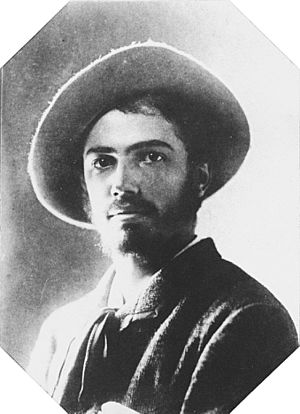Adolphe Appia facts for kids
Quick facts for kids
Adolphe Appia
|
|
|---|---|

Adolphe Appia in 1882
|
|
| Born | 1 September 1862 Geneva, Switzerland
|
| Died | 29 February 1928 (aged 65) |
| Nationality | Swiss |
| Occupation | Architect Set designer Lighting designer |
Adolphe Appia (born September 1, 1862 – died February 29, 1928) was a Swiss architect and a very important thinker about stage lighting and décor (stage design). He was the son of Louis Appia, who helped start the Red Cross. Adolphe Appia changed how people thought about theatre, especially how light and sets could make a play feel more real and exciting.
Contents
Early Life and Studies
Adolphe Appia grew up in Geneva, Switzerland. When he was 11, he went to a boarding school called Collège de Vevey. He stayed there until he was 17.
At 16, he saw his first professional play, an opera called Faust by Charles Gounod. This experience likely sparked his interest in theatre. He later studied music in Leipzig (from 1882 to 1883) and Dresden (from 1886 to 1890).
Career and New Ideas
Appia is famous for his many stage designs for the operas of Richard Wagner. He didn't like the old way of using flat, painted backgrounds on stage. Instead, he wanted to use three-dimensional (3D) sets. He believed that shadows were just as important as light. He thought light and shadow helped connect the actors to the stage setting.
By carefully controlling the brightness, color, and movement of light, Appia created a completely new way of designing stages and lighting. Many theatre directors and designers today are still inspired by his ideas. His work was especially important because he lived when electric lighting was just starting to be used in theatres. He was a visionary who could imagine new possibilities for the stage.
Appia's Theatre Theories
A main idea in Appia's work was that everything on stage should work together as one artistic whole. He thought that flat, painted sets made plays feel fake and disconnected. He believed that three things were key to making a unified and powerful stage picture (called mise-en-scène):
- Actors moving in a lively and 3D way.
- Scenery that stood up straight and had depth.
- Using the full depth and width of the stage space.
Appia saw light, space, and the human body as flexible tools. He thought they should be combined to create a unified stage. He wanted sound, light, and movement to happen at the same time in his productions of Wagner's operas. He tried to make groups of actors move with the music's rhythm and mood.
Most importantly, Appia saw light as the main element that brought everything together. He always tried to connect the music and movements to the more symbolic parts of light. He often had actors start and end with strong, meaningful poses. In his plays, light was always changing, controlled moment by moment. Appia wanted to unify stage movement, the use of space, and the overall rhythm of the performance.
Appia was one of the first designers to understand that stage lighting could do more than just show the actors. His ideas about staging "word-tone drama" (a type of opera) and his own productions of Tristan und Isolde (in Milan, 1923) and parts of The Ring (in Basel, 1924–25) influenced many later stage productions, especially in the late 20th century.
Appia's designs and theories inspired many other theatre artists, like Edward Gordon Craig, Jacques Copeau, and Wieland Wagner.
Works
- L’œuvre d’art vivant (The Living Work of Art). 1921
- La mise en scéne du théatre Wagnerien (The Staging of Wagnerian Theatre). Paris, 1895
- Musique et mise en scéne (Music and Staging), 1897
Filmography
- Adolphe Appia, Visionary of Invisible (1988), a film by Louis Mouchet
Images for kids
See also
 In Spanish: Adolphe Appia para niños
In Spanish: Adolphe Appia para niños


